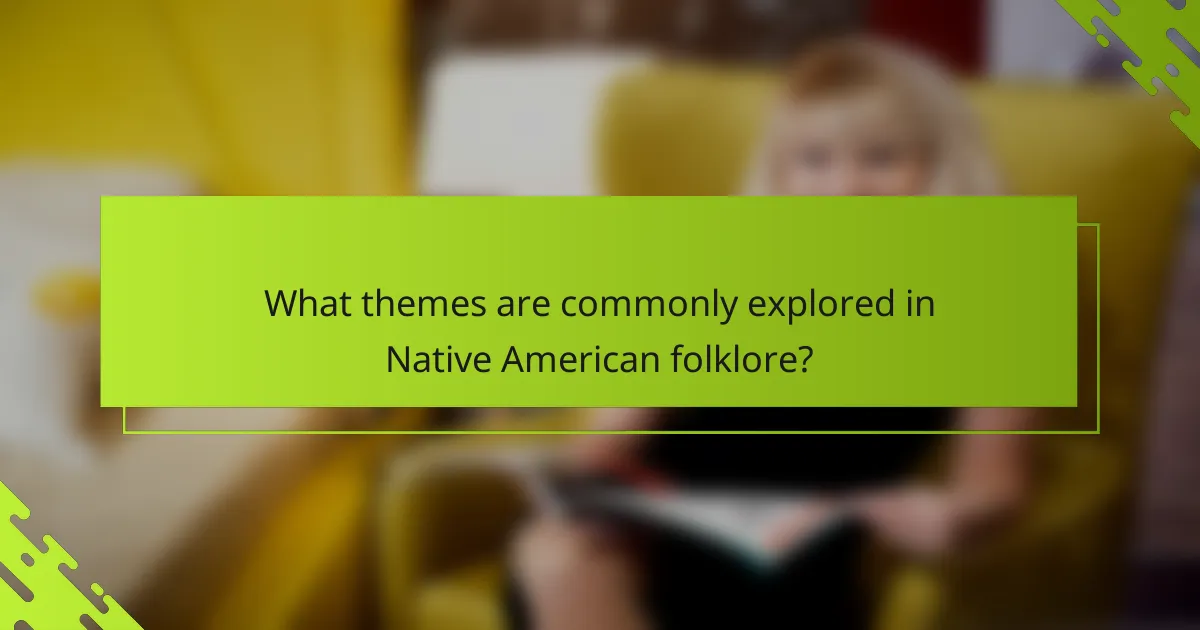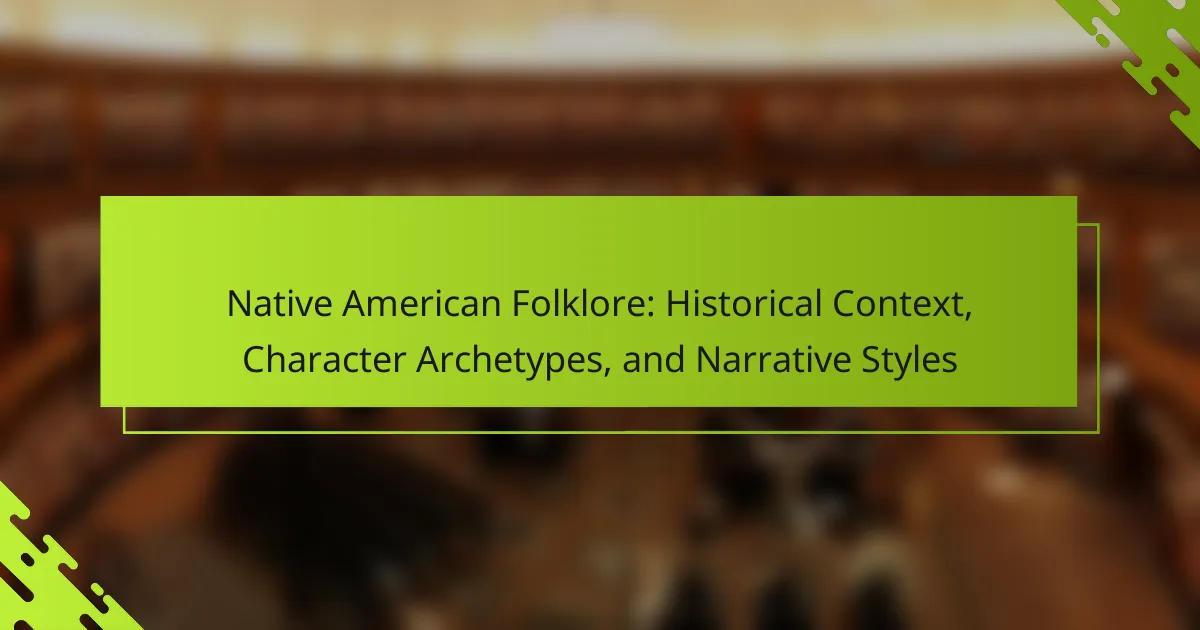Understanding Native American folklore reveals its rich historical context, character archetypes, and diverse narrative styles. Historical events shape themes and characters, reflecting resilience. Prominent archetypes include the trickster, hero, and wise elder, each teaching cultural values. Narrative styles vary among tribes, showcasing unique storytelling techniques that preserve cultural identity and wisdom.

How does historical context shape Native American folklore?
Historical context significantly influences Native American folklore by shaping its themes, characters, and narratives. Historical events, such as colonization and cultural exchanges, inform the stories and archetypes found in folklore. For instance, many tales reflect the struggles and resilience of Native American communities in the face of adversity. The unique attribute of oral tradition allows these stories to adapt over time, preserving cultural identity. Additionally, the incorporation of historical elements enriches the narrative styles, making them more relevant to contemporary audiences. This interplay between history and storytelling creates a dynamic folklore that continues to evolve while honouring its roots.
What are the key historical events influencing folklore narratives?
Key historical events influencing Native American folklore narratives include colonization, cultural exchange, and resistance. The arrival of European settlers drastically altered indigenous lifestyles and beliefs, leading to the adaptation of traditional stories. Additionally, significant events such as treaties, wars, and forced relocations shaped the narratives, embedding themes of survival and resilience. These historical contexts fostered unique character archetypes, such as the trickster, often reflecting societal challenges. Overall, the interplay of historical events and folklore illustrates the enduring legacy of Native American cultures.
How do different tribes’ histories reflect in their stories?
Different tribes’ histories are reflected in their stories through unique character archetypes and narrative styles that capture cultural values. Each tribe’s folklore often embodies historical events, moral lessons, and spiritual beliefs, shaping individual identities. For instance, the use of animals as characters can symbolize traits valued in specific tribes, such as bravery or wisdom. Additionally, oral traditions preserve historical contexts, allowing stories to evolve while maintaining connections to ancestral experiences. This blend of history and storytelling fosters a rich tapestry of cultural heritage across Native American tribes.
What role does oral tradition play in preserving history?
Oral tradition plays a crucial role in preserving Native American history by transmitting cultural knowledge through storytelling. These narratives encapsulate values, beliefs, and historical events, ensuring continuity across generations. Character archetypes, such as the trickster or the hero, embody lessons and morals, enriching the cultural fabric. Narrative styles vary widely, reflecting diverse tribal identities and experiences, thus maintaining a rich historical context. This preservation method fosters community cohesion and identity, making it essential for cultural survival.
Which external influences have altered traditional narratives?
External influences such as colonialism, globalization, and modern media have significantly altered traditional Native American folklore narratives. Colonialism imposed foreign values and beliefs, often distorting indigenous stories. Globalization facilitated the exchange of cultural elements, leading to hybrid narratives. Modern media, including film and literature, has reinterpreted folklore, sometimes reinforcing stereotypes while also providing platforms for authentic voices. These influences have reshaped character archetypes and narrative styles, creating a dynamic interplay between tradition and contemporary expression.

What character archetypes are prevalent in Native American folklore?
Native American folklore features several prevalent character archetypes, including the trickster, the hero, and the wise elder. The trickster often embodies cunning and adaptability, teaching lessons through mischief. Heroes are typically brave figures who undertake significant quests, reflecting cultural values. Wise elders serve as guardians of knowledge, offering guidance and wisdom. These archetypes illustrate the rich narrative styles and themes inherent in Native American storytelling traditions.
How do trickster figures function within these stories?
Trickster figures in Native American folklore serve as agents of change and challenge societal norms. They often embody duality, representing both chaos and wisdom. These characters use humour and cunning to disrupt the status quo, teaching valuable lessons through their antics. For instance, Coyote and Raven frequently illustrate the thin line between creation and destruction, emphasizing the importance of balance in life. Their narratives often reveal deeper truths about human nature and the environment, making them essential to the cultural fabric of Native American storytelling.
What qualities define the hero archetype in Native American tales?
The hero archetype in Native American tales is defined by qualities such as bravery, wisdom, and a deep connection to nature. Heroes often embark on transformative journeys, facing challenges that test their character and resilience. They embody cultural values, serve as protectors of their communities, and strive for harmony with the environment. Unique attributes include their ability to communicate with animals and spirits, reflecting a rare spiritual connection in these narratives.
Which female archetypes are commonly represented, and what do they signify?
Common female archetypes in Native American folklore include the Earth Mother, the Wise Woman, and the Trickster. The Earth Mother symbolizes fertility and nurturing, often representing the life-giving aspects of nature. The Wise Woman embodies knowledge and guidance, serving as a source of wisdom within the community. The Trickster, while often male, can have female representations that challenge norms and provoke thought, signifying adaptability and change. Each archetype reflects cultural values and societal roles within Native American narratives.

How do narrative styles vary across different tribes?
Narrative styles in Native American folklore vary significantly among tribes, reflecting their unique cultures and histories. Each tribe employs distinct storytelling techniques, structures, and themes that reveal their values and beliefs.
For instance, the Navajo often use circular storytelling, emphasizing the interconnectedness of life, while the Lakota might focus on heroic journeys and moral lessons. The use of animals as characters, a common thread, varies in symbolism and meaning across tribes.
Additionally, oral traditions play a crucial role in these narratives, with storytelling being a communal activity that strengthens social bonds. The shared experience of storytelling allows for the transmission of history and wisdom, adapting to contemporary contexts while preserving cultural identity.
The diversity of narrative styles illustrates the rich tapestry of Native American folklore, showcasing how each tribe’s unique perspective shapes their stories.
What storytelling techniques are unique to specific regions?
Native American folklore employs unique storytelling techniques that reflect cultural values and historical contexts. These narratives often feature oral traditions, emphasizing communal knowledge and the interconnectedness of nature and humanity.
Character archetypes include tricksters, heroes, and animal figures, each embodying moral lessons. For example, the coyote often represents cunning and adaptability. Narrative styles frequently incorporate circular storytelling, where tales begin and end in a similar place, reinforcing themes of continuity and balance.
The use of symbolism is prevalent, with elements like animals and natural phenomena conveying deeper meanings. Additionally, these stories often blend the spiritual with the mundane, illustrating the belief in a world where the supernatural influences daily life.
Overall, Native American storytelling is a rich tapestry that combines history, morality, and cultural identity, making it distinct and significant.
How does the use of symbolism enhance narrative depth?
Symbolism enriches narrative depth in Native American folklore by conveying complex themes and cultural values. Through symbols, stories transcend literal meanings, allowing for deeper emotional and spiritual connections. For example, the use of animals often represents traits or lessons, enhancing character archetypes and moral teachings. This layered approach invites readers to explore the richness of cultural heritage, fostering a greater understanding of historical contexts and narrative styles. Symbolism also highlights unique attributes of Native American storytelling, emphasizing interconnectedness with nature and community.
Which forms of storytelling are most effective in conveying moral lessons?
Native American folklore employs oral traditions, parables, and symbolic narratives to effectively convey moral lessons. These storytelling forms engage listeners through relatable characters and culturally relevant themes.
Oral traditions often emphasize community values and shared experiences, fostering a sense of belonging. Parables, with their concise moral messages, provide clear ethical guidance. Symbolic narratives utilize metaphors and archetypes, such as tricksters or wise elders, to illustrate complex moral dilemmas and lessons.
The effectiveness of these forms lies in their ability to resonate emotionally with audiences, making moral lessons memorable and impactful.

What themes are commonly explored in Native American folklore?
Native American folklore commonly explores themes of creation, nature, morality, and the interconnectedness of all beings. These narratives often feature character archetypes such as tricksters, heroes, and animals, reflecting cultural values and teachings. Storytelling techniques vary, incorporating oral traditions, songs, and rituals, which enhance the richness of the narratives. Additionally, folklore serves as a means of preserving history and imparting wisdom across generations.
How do themes of nature and the environment manifest in stories?
Themes of nature and the environment are central in Native American folklore, reflecting deep connections to the land. These stories often portray nature as a living entity, emphasizing interdependence between humans and the environment. Character archetypes, such as tricksters and animal spirits, embody natural elements, illustrating moral lessons and cultural values. Narrative styles frequently incorporate oral traditions, using vivid imagery and symbolism to convey respect for nature. This holistic view fosters a sense of stewardship, highlighting the importance of preserving the environment for future generations.
What role do cultural values play in thematic development?
Cultural values significantly shape thematic development in Native American folklore. These values influence character archetypes, narrative styles, and moral lessons. They reflect community beliefs, traditions, and historical contexts, providing depth to the stories. For example, themes of harmony with nature and respect for ancestors are prevalent. Such values create unique storytelling methods, emphasizing oral traditions and communal experiences. The interplay between cultural values and narrative forms enriches the understanding of these folktales, highlighting their significance in preserving identity and heritage.
Which contemporary issues are addressed through traditional narratives?
Traditional narratives in Native American folklore address contemporary issues such as cultural identity, environmental stewardship, and social justice. These stories often reflect the values and beliefs of Indigenous communities, emphasizing the importance of harmony with nature and the preservation of cultural heritage. For example, tales of creation and moral lessons promote respect for the earth and its resources. Additionally, character archetypes in these narratives often embody resilience and wisdom, serving as role models in navigating modern challenges. Through storytelling, these narratives provide a framework for discussing and understanding current social and environmental issues.

How is Native American folklore being adapted in modern media?
Native American folklore is being adapted in modern media through diverse storytelling techniques and character portrayals. Filmmakers and authors are increasingly integrating traditional narratives into contemporary formats, enhancing representation and cultural understanding.
For instance, animated films and series often feature Native American characters and themes, bringing ancient tales to younger audiences. Video games are incorporating folklore elements, allowing players to engage with cultural stories interactively.
This adaptation process emphasizes unique attributes of folklore, such as its moral lessons and spiritual connections, making them relevant in today’s context. As a result, modern adaptations foster a deeper appreciation for Native American heritage while addressing contemporary issues.
Which films and literature have successfully integrated these stories?
Several films and literary works have effectively integrated Native American folklore. Notable examples include “Dances with Wolves,” which explores themes of cultural connection and respect for nature. “Smoke Signals,” based on Sherman Alexie’s work, delves into identity and storytelling. “The Lone Ranger” incorporates elements of folklore, showcasing character archetypes like the noble warrior. Additionally, “The Round House” by Louise Erdrich weaves traditional narratives into a contemporary setting, highlighting the intersection of past and present. These works illustrate the rich narrative styles and character archetypes inherent in Native American storytelling.
How do adaptations impact cultural perception and understanding?
Adaptations significantly shape cultural perception and understanding of Native American folklore. They reinterpret traditional narratives, making them accessible to wider audiences while preserving core themes. These adaptations often highlight character archetypes and narrative styles, emphasizing values such as community, nature, and spirituality. By engaging with these stories, audiences gain insight into the diverse cultural contexts and historical experiences of Native American communities. This process fosters appreciation and respect for indigenous perspectives, contributing to a broader understanding of cultural diversity.
What are the challenges of accurately representing folklore in media?
Accurately representing Native American folklore in media faces significant challenges. Misinterpretation of cultural symbols can distort narratives, leading to stereotypes. Additionally, the diversity of tribes means that a single portrayal may not encompass all traditions. Authentic representation requires collaboration with Native communities to ensure respect for their stories. Furthermore, commercial interests often prioritize entertainment over cultural accuracy, risking the integrity of the folklore.

What are the best practices for studying Native American folklore?
To study Native American folklore effectively, immerse yourself in its historical context, explore character archetypes, and analyze narrative styles. Understanding the cultural significance and regional variations enhances appreciation. Engage with primary sources, oral traditions, and contemporary interpretations. Collaborate with Native scholars and communities to gain authentic insights.
How can one approach folklore with cultural sensitivity?
Approaching Native American folklore with cultural sensitivity requires respect for its historical significance and diverse narratives. Engage with authentic sources and community perspectives to understand the context and meanings behind stories. Acknowledge the unique attributes of each tribe’s folklore, recognizing variations in character archetypes and narrative styles. Avoid generalizations and stereotypes, focusing instead on the rich, multifaceted nature of these traditions. Building relationships with Native communities fosters deeper insights and appreciation for their cultural heritage.
What resources are available for deeper understanding?
Numerous resources are available for a deeper understanding of Native American folklore. Books such as “American Indian Myths and Legends” provide rich narratives and context. Scholarly articles explore historical contexts and character archetypes. Online databases and cultural organizations offer access to oral traditions and community insights. Documentaries and podcasts further illustrate narrative styles and their significance.
Which common mistakes should be avoided in folklore research?
Avoiding common mistakes in folklore research is crucial for accuracy and respect. Key pitfalls include generalizing Native American cultures, overlooking oral traditions, and neglecting historical context.
Generalizing can lead to misrepresentations of diverse tribes and their unique narratives. Oral traditions are vital; failing to account for them diminishes the authenticity of the research. Historical context is essential to understanding character archetypes and narrative styles. Ignoring this can result in incomplete interpretations.
Additionally, researchers should avoid using outdated or biased sources, as they can perpetuate stereotypes. Engaging with contemporary Native voices is essential for a well-rounded perspective.
